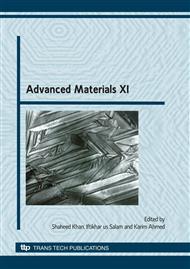[1]
Li Wang, Wei Chen, Andrew Thye Shen Wee, Surface Science Reports, Vol. 63 (2008), p.465.
Google Scholar
[2]
B.N. Holland, G. Cabailh, N. Peltekis, C. McGuinness, A.A. Cafolla, I.T. McGovern, Applied Surface Science, Vol. 255 (2008), p.775.
DOI: 10.1016/j.apsusc.2008.07.080
Google Scholar
[3]
Sang Wan Cho, Yeonjin Yi, Myungkeun Noh, Mann-Ho Cho, Kyung-Hwa Yoo, Kwangho Jeong, Chung-Nam Whang , Synthetic Metals, Vol. 158 ( 2008), p.539.
Google Scholar
[4]
F. Petraki, V. Papaefthimiou, S. Kennou , Organic Electronics, Vol. 8 ( 2007), p.522.
Google Scholar
[5]
F.S. Tautz , Progress in Surface Science, Vol. 82( 2007) 479.
Google Scholar
[6]
R.L. Van Merhaeghe, W.H. Laflere, F. Cardon, J. A ppl. Phys. Vol. 76 (1994), p.403.
Google Scholar
[7]
Dietrich R. T. Zahn, Sunggook Park, Thorsten U. Kampen , Vacuum, Vol. 67 ( 2002), p.101.
Google Scholar
[8]
S. Antohe, N. Tomozeiu, S. Gogonea, Phys. Status Solidi (a) Vol. 125 (1991), p.397.
Google Scholar
[9]
Haibo Wang, Jun Wang, Haichao Huang, Xuanjun Yan, Donghang Yan, Organic Electronics, Vol. 7 (2006), p.369.
Google Scholar
[10]
T. D. Anthopoulos, T. S. Shafai , Journal of Physics and Chemistry of Solids, Vol. 64 ( 2003), p.1217.
Google Scholar
[11]
A. Ray, S.K. Gupta, J.V. Yakhmi , Radiation Measurements, In Press, Accepted Manuscript, Available online 26 October (2008).
Google Scholar
[12]
Dario Natali, Marco Sampietro, Nuclear Instruments and Methods in Physics Research Section A: Accelerators, Spectrometers, Detectors and Associated Equipment, Vol. 512 (2003), p.419.
DOI: 10.1016/s0168-9002(03)01921-1
Google Scholar
[13]
Kihyun Kim, Tae Ho Kwak, Mi Yeon Cho, Jin Woo Lee, Jinsoo Joo , Synthetic Metals, Vol. 158 (2008), p.553.
Google Scholar
[14]
Liwei Shang, Ming Liu, Deyu Tu, Lijuan Zhen, Ge Liu, Rui Jia, Liqiang Li, Wenping Hu , Thin Solid Films, Vol. 516 (2008), p.5093.
DOI: 10.1109/icsict.2008.4734713
Google Scholar
[15]
Rongbin Ye, Mamoru Baba, Kazunori Suzuki, Kunio Mori , Thin Solid Films, In Press, Accepted Manuscript, Available online 20 November (2008).
Google Scholar
[16]
X. Liu, Y. Bai, L. Chen, F.X. Wei, X.B. Zhang, X.Y. Jiang, Zh.L. Zhang, Microelectronics Journal, Vol. 38 ( 2007), p.919.
Google Scholar
[17]
Stephen Maldonado, Edgardo García-Berríos, Marc D. Woodka, Bruce S. Brunschwig, Nathan S. Lewis, Sensors and Actuators B: Chemical, Vol. 134 ( 2008), p.521.
DOI: 10.1016/j.snb.2008.05.047
Google Scholar
[18]
S. Nespurek, O. Zmeskal, J. Sworakowski, Thin Solid Films, Vol. 516 (2008), p.8949.
Google Scholar
[19]
H.S. Soliman, A.A.M. Farag, N.M. Khosifan, M.M. El-Nahass, Thin Solid Films, Vol. 516 (2008), p.8678.
DOI: 10.1016/j.tsf.2008.04.102
Google Scholar
[20]
M.M. El-Nahass, H.M. Zeyada, M.S. Aziz, N.A. El-Ghamaz, Solid-State Electronics, Vol. 49 (2005), p.1314.
DOI: 10.1016/j.sse.2005.06.001
Google Scholar
[21]
M.M. El-Nahass, A.M. Farid, A. A.M. Farag, H. A.M. Ali, Vacuum, Vol. 81 ( 2006), p.8.
Google Scholar
[22]
S. Senthilarasu, R. Sathyamoorthy, S. Lalitha, A. subbarayan, Solar Energy Materials and Solar Cells, Vol. 90 (2006), p.783.
DOI: 10.1016/j.solmat.2005.04.015
Google Scholar
[23]
J. Ivanco, T. Haber, R. Resel, F.P. Netzer, M.G. Ramsey, Thin Solid Films, Vol. 514 ( 2006), p.156.
DOI: 10.1016/j.tsf.2006.02.018
Google Scholar
[24]
G. Jorosz, J. Non-Cryst. Solids, Vol. 352 (2006), p.4264.
Google Scholar
[25]
Sze, S. M., 1936- Semiconductor devices, physics and technology, JOHN WILEY & SONS, Singapore, 1985, p.91, 296, 95.
Google Scholar
[26]
Mehmet E. nver Aydin, Fahrettin Yakuphanoglu, Jae-Hoon Eom, Do-Hoon Hwang, Physica B, Vol. 387 (2007), p.239.
Google Scholar
[27]
A. M. Cowley, S. M. Sze, Appl. Phys. Vol. 36 (1965), p.3212.
Google Scholar
[28]
A. E. Rakhshani, Y. Makdisi, X. Methew, J. of Materials Sc.: Materials in Elect. Vol. 8 (1997), p.207.
Google Scholar


